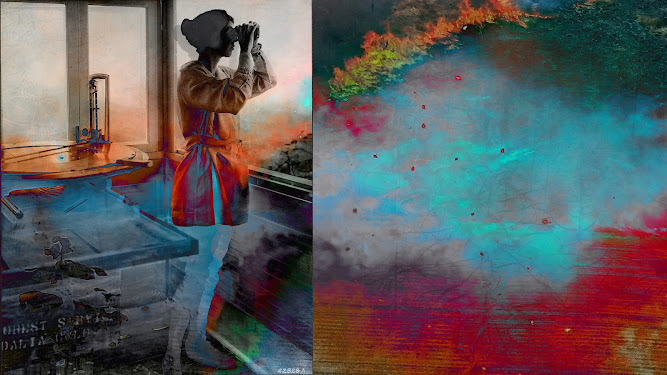 |
| "Right View" by Ameera Godwin |
In this state of mind, I can start to experience a quality of "right view.": seeing what is true, and discerning how to respond, compassionately, ethically. I try to cultivate a relationship to temporality, "as an on-going purposeful effort to create one’s time and keep up one’s sensed continuity in time," as described by Estonian researcher, Kätlin Pulk.
Working with digital video and using various non-narrative film approaches, my raw materials are the moving pixels with attributes like duration, speed, frequency, synchrony and asynchrony with audio, which make up a flexible palette.
Making video collage can create surprising effects in the present, while also providing a way to manipulate and overlay multiple pasts and futures. In FIRE/LAND: Knowing the Territory, the early founding of the US Forest Service is portrayed in theatrical form with actors, singers, movement, and musicians, while simultaneously, video projected across the stage shows a stream of images of forest, firefighting, lumbering, politics, power structures, and wildfire spanning the 20th century until today. The video juxtaposes and magnifies pasts and present. The "Big Burn" wildfire of 1910, for example, is overlaid with the 2021 Caldor Fire, to offer a visual and musical elegy in remembrance of the experiences of grief and loss.
FIRE/LAND jumps through time to offer lessons and hope. In quick succession, we present that Swedish scientist, Svante Arrhenius accurately calculated global warming in 1895, that Native Americans applied the beneficial uses of fire to tend the land over thousands of year, and that when combined with current science-based practices and policies, we see that intentional fire has the potential to remediate damage done to the forest and land through neglect, greed, and ignorance. With the "right view" that time is running out on us, FIRE/LAND seeks to activate the audience around resilience, toward creating a legacy of positive effects that can last longer than this passing instant.
-- Ameera Godwin, Co-Founder and Artistic Director, Myrtle Tree Arts
FIRE/LAND
An Experience Inspiring Community Resilience
Saturday, June 10th, 2023, 4PM - 10PM
Wakamatsu Farm, 941 Cold Springs Road, Placerville, CA 95667
A project of Myrtle Tree Arts and co-hosted by the American River Conservancy, this unique "art rock opera for the forest" and public forum will happen at the landmark Wakamatsu Farm. During the speaker forum in the late afternoon, local experts and representatives will share community issues related to wildfire, land stewardship, emergency preparedness, cultural preservation, and forest ecology. The evening features Main Street Collective's Pink Floyd Dark Side of the Moon 50th Anniversary concert followed by FIRE/LAND: Knowing the Territory, a musical and dramatic performance starring musicians, singers, Native American storyteller, and video projections in a creative exploration of wildfire, ecological change, and resilience in El Dorado County. This intellectual and creative experience strives to spark inspiration and your call to action in support of community resilience! See more details on the Myrtle Tree Arts Fire/Land page.
FIRE/LAND: The Exhibition
SWITCHBOARD GALLERY
Arts and Culture El Dorado
525 Main St. Placerville, CA
June 8 - August 6, 2023
Experience this installation of Ameera Godwin's digital prints and video from FIRE/LAND.
Artist Talk, July 13th, 6pm
FIRE/LAND is made possible with support from:
The Latrobe Fund, Sacramento Region Community Foundation,
Pure Life/Sacred Roots, in partnership with the
American River Conservancy and Arts and Culture El Dorado
Comments
Post a Comment